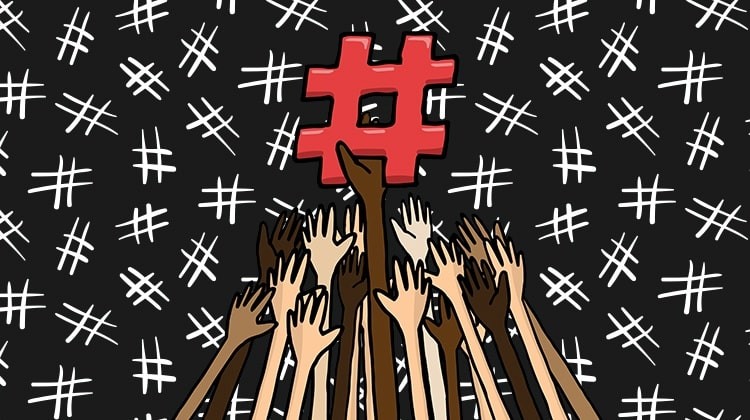by Cydney Hatch • December 27, 2018
The Ultimate Guide to Hashtags for Businesses
Let’s talk about hashtags (originally known as the pound sign, pre-2007).
From its humble origin as an easy keyboard character to reach on the 2007 Nokia cellphone, it’s now become an intricate and powerful internet chat system that has changed how we communicate online.
Since social engagement is the name of the game these days, when it comes to social media marketing success, hashtags are a great way to get the traffic numbers you want for your content!
Now, to make hashtags effective, you do not want to be one of those businesses playing the guessing game every time you post something. Hashtag hail marys do not work, so in this article, we will talk about everything you need to know about hashtags and how to use them effectively for your business.
What are Hashtags and Why Do I Need Them?
Simply put, the # symbol, popularly used on Twitter, Facebook and Instagram, groups content with other posts about the same topic.
With hundreds of thousands of images being posted on social platforms daily, it can be hard to get your content out there to the people who need to see it, outside of your followers.
That’s where hashtags come into play.
By including hashtags in your content, you help social platforms index your content in a way that is discoverable to everyone, not just your followers. For example, if you are a company that is selling kids shoes you can add the hashtags #kidsshoes or #littleshoes to your Instagram posts, like below, to snag people looking for little kids shoes!
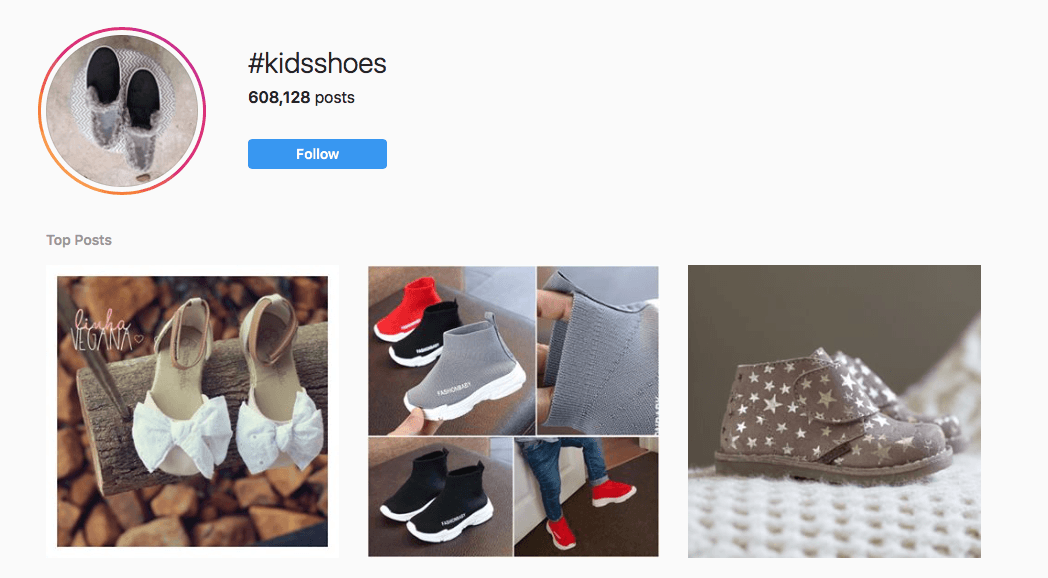
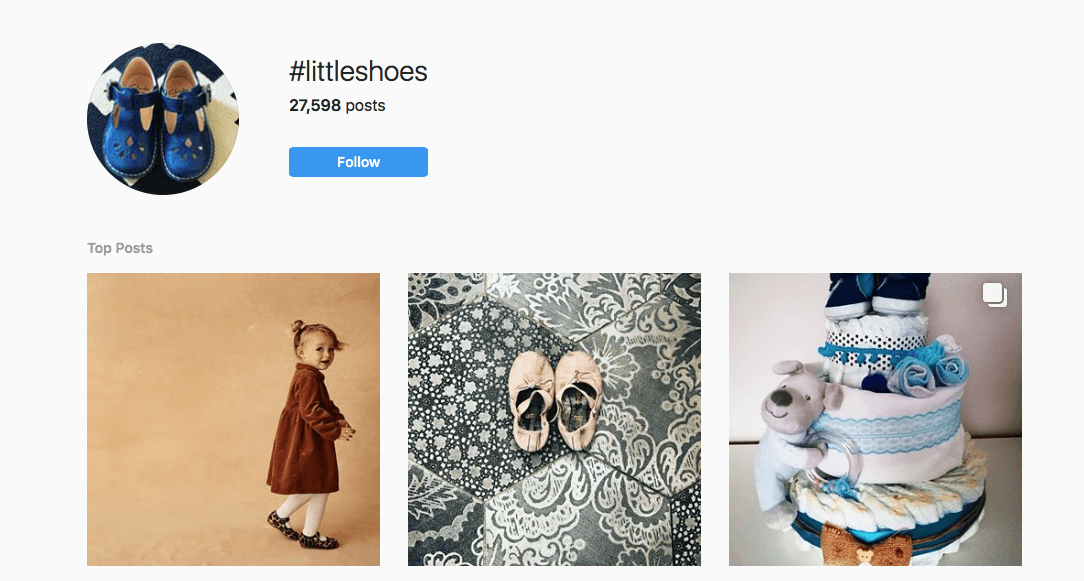
As shown in examples above, the benefit to hashtags is that your posts are not limited to just your immediate followers and your business can be found by users actively looking for things online.
In addition:
- Hashtags Simplify Searches: Searching specific hashtags make online research easy for people using social media. Looking for #lipcolors? Typing that hashtags allows the person to find loads of relevant content.
- Hashtags Create Action: When a person sees a post that sparks their interest, they will likely spend time looking through more content brought up by the hashtag account. Hashtags allow people to take action and explore your brand.
- Hashtags are Here to Stay: Hashtags are being used a ton by social media platforms and that usage is evolving! This is impacting the amount of information put directly in front of social media users!
- Hashtags Help You Nail Your Niche: Hashtags make finding content a lot easier for social media users. A unique hashtag can develop a niche where your message can stand out to the users who find the hashtag valuable.
There is so much to know about hashtags, but to better understand what hashtags are all about, there are three main types of hashtags to be aware of:
Content Hashtags
If you are totally new to hashtags, first consider using some that are obvious explanations of your product, service, market or medium.
These are called content hashtags and they describe the type of content your post contains. Using these types of general hashtags pulls your posts into a big pool of content, but by being included in a general hashtag group it will greatly expose your brand to potential customers who weren’t previously familiar with your brand.
For example, Modcloth uses hashtags related to fashion, as they are an apparel company selling unique, whimsical and vintage-inspired clothing/accessories. In one of their recent holiday Instagram posts, they used content hashtags related to winter fashion—such as #winterfashion, #holidaystyle, or #holidaystyle.
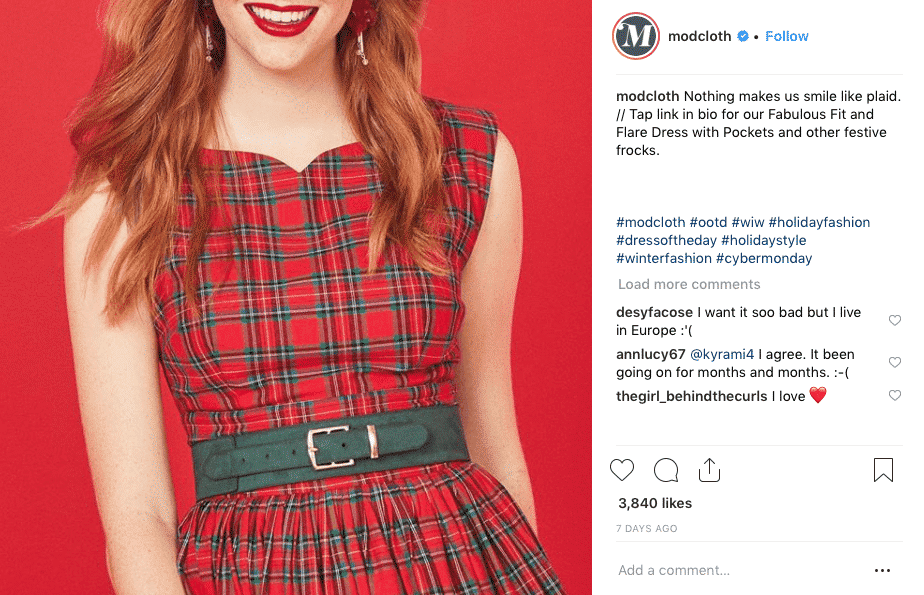
These are general content hashtags pool their images with other holiday and winter fashion posts.
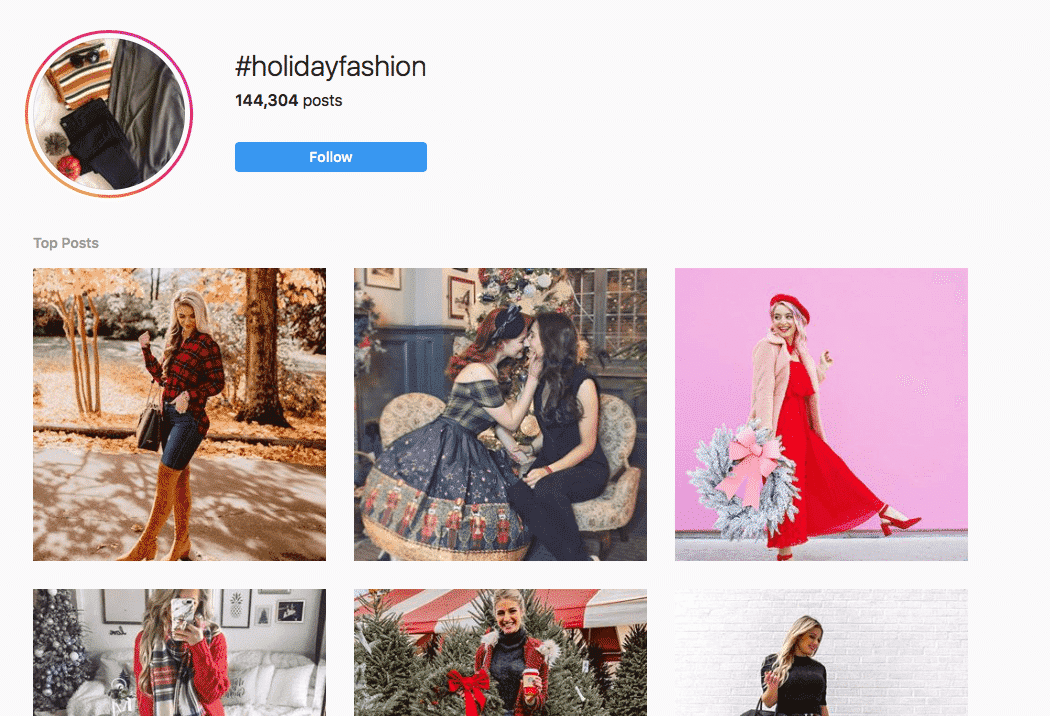
These posts now have the possibility of getting featured in places you know people are clicking on or searching to find inspiration. While there’s a chance it might get buried, it also had a chance to stand out!
You can easily be found for general searches and if you are a top post, you appear as a top result! Sweet!
Narrowing Content Down
The opposite of these are a bit narrower content hashtags. So, for example, if you are a wedding photographer in Honolulu, Hawaii you would want to use more narrow hashtags outside of #weddingphotographer #weddingphotography like : #Honolulubride, #Hawaiiwedding, #Honoluluwedding, #(venue), #(vendors)…
These hashtags, although still broad, are much more specific to a certain market and will likely move the profit needle more because they connect businesses with people who might actually become clients!
Trending Hashtags
Another great way to boost your traffic is using popular hashtags or viral hashtags known as trending hashtags.
Although being apart of a #trend is appealing, you want to make sure that your post is adding value to the online conversation and not creating a disconnect from the hashtag and your content. Keep in mind that value is not just information, it can be an opinion, funny statement or image.
If your post is informative, funny or helpful it will get shared by fellow social-media-ers, ultimately increasing awareness of your brand. Trending hashtags range from holidays and social movements to random spur of the moment trends. For example, December 4th is National Cookie Day and therefore many brands will want to post something at cookies.
Two accounts who do not naturally have a connection to cookies made trending hashtags work for them on Twitter:
Visit Holland, an account source for tips to ensure you have the best time in Holland, created a relevant cookie post featuring Dutch cookies:

A personal account called Invisible Man, again has no ties to cookie-making or selling, but yet has made a relevantly funny post for #nationalcookieday:
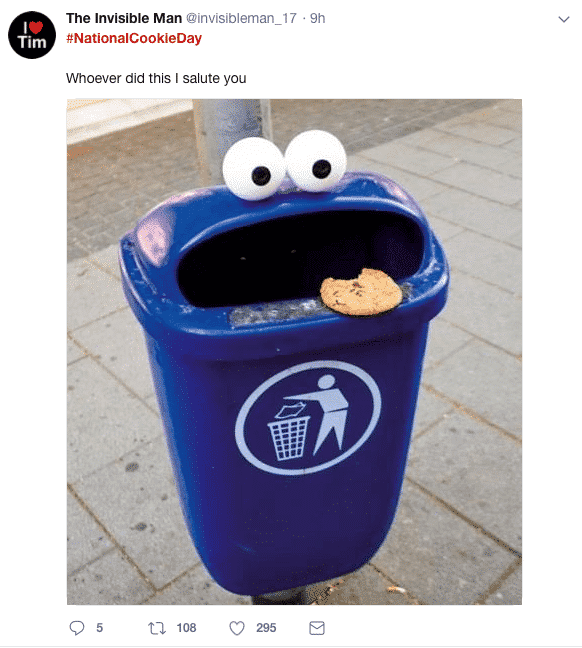
Both of these posts are different and not naturally aligned with the hashtag of #nationalcookieday, but they both created content that is relevant to the hashtag by using branding and humor.
Branded Hashtags
Sometimes, the problem with using generic or popular hashtags is that your posts might be lost amongst hundreds of content pieces with the same hashtag.
If you are a business that plans to be around for a while, it might be a good idea to start creating your own dedicated branded hashtags! These can be used for general branding, promotions, events, contests or other marketing campaigns.
The key to creating an effective branded hashtag is to ensure that there is no one else has claimed it. It has to be unique and memorable!
To help you brainstorm, think about your:
- Slogans
- Catch Phrases
- Names
- Mottos
- Campaigns
The key to using branded hashtags and making them successful is giving social media users a reason to use them. For example, you could get users to post with a campaign-specific hashtag to get discounts, have their photos featured on your account or win prizes.
By doing that, your business gets benefit from high traffic publicity!
For example, REI stood out to consumers on a mixed feeling holiday, Black Friday. As many people wonder if we are truly grateful after Thanksgiving due to Black Friday shopping, REI made a statement using the hashtag #OptOutside.
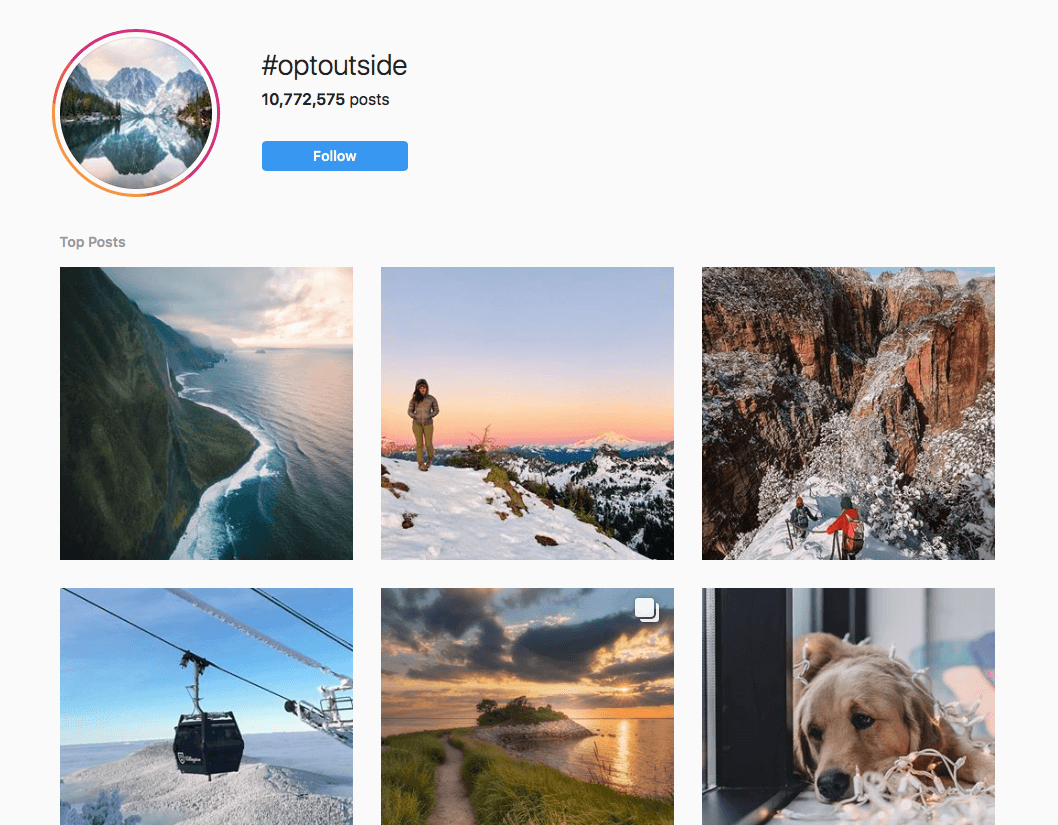
To REI, spending time outdoors is important so they pay their employees to #OptOutside every Black Friday and invite the world to join resulting in 10 million people joining in on the conversation on Instagram ALONE!
Like them, you can create specifically branded hashtags that can tie social traffic directly to your business or brand.
Hashtag Platforms and Best Practices
If you are interested in using hashtags, it might be best to know which platforms you can use this social media marketing strategy on! Luckily, most major social media platforms support hashtags including:
 Tumblr
Tumblr
Tumblr posts have a “tagging” section where a user can include “tags” or their own version on hashtags. These tags function like other hashtags, organizing posts by topic. Hashtags included in the main body of a post are not transformed into links.
Best Practices:
- # of Hashtags to Use: Tumblr allows you to use 30 but only the first 20 are relevant.
- Where to Place Them: Enter the tags in the field at the bottom of the post form.
Use Pinterest hashtags to get your content marked for searches. Click on the hashtag in a pin description to navigate results that contain the exact hashtag, plus pins with the same word or phrase in the description.
Best Practices:
- # of Hashtags to Use: 20 per post.
- Where to Place Them: Hashtags only work within the Pins’ descriptions.
Facebook is newer to hashtags as they only added the feature in 2013, but the use of them on Facebook as not been as popular as on other platforms. Clicking on Facebook hashtags will take you to a list of posts containing the same hashtag as it would for a Twitter hashtag feed.
Best Practices:
- # of Hashtags to Use: 2-4 or less.
- Where to Place Them: Hashtags can be used at the end of a post or incorporated as part of the sentence.
Twitter is the birthplace of the hashtag, so it has more usage and database for content than other sites. Twitter hashtags are mainly used to denote specific topics of conversation. The “Trends” sidebar of your Twitter feed curates a list of hashtags you might be interested in, based on your tweets.
When you search for a hashtag on Twitter, there are three ways to filter the results. The “Top” option displays the most relevant and popular posts, including those from users you don’t follow. “All” shows you every tweet that uses the specific hashtag in real time and “People you follow” will only display results from users you are following.
Best Practices:
- # of Hashtags to Use: Ideally 2-3.
- Where to Place Them: It can be used at the end of a Tweet or incorporated as part of the sentence.
Hashtags can be used to complement photos shared on Instagram and help you discover new accounts and pick up followers. Some hashtags were created specifically for Instagram photo challenges — #ThrowbackThursday, for example, encourages users to post old photos of themselves, their brand or anything that is retro.
Best Practices:
- # of Hashtags to Use: 5-10.
- Where to Place Them: At the end of your caption preferably separated by either dots or asterisks. If you’re a neat freak, you can also add your hashtags in a comment to your post.
So, now that you know everything you need to know about hashtags, let’s take a look at how you can use it for your business effectively to raise your traffic numbers and followers!
How to Use Hashtags for Your Business: Tips Just For You!
There are a lot of content and traffic on social media these days but one of the most valuable ways you can use hashtags for your businesses is to gain a spot at the table of online conversations, especially ones that matter to us, our business, and to connect us to the right people.
Identifying the right hashtags that will align your brand and content with the right audience is the goal and objective of hashtags. If you want to learn more or need some ideas on how to use them, below are some tips and tricks on how you can use hashtags to greatly benefit your content and business:
Have a Game Plan in Mind
At this point, you might be trying to wrap your brain around hashtags you want to use for your business or brand but you might also be asking “how do you know which ones to use and when? ”
To answer that question, it’s helpful to first think about these two things when trying to think of useful hashtags:
- What is the Goal?
- What Topics or Categories Does This Post Contain?
(Is it in a specific geographic area? Does it feature any brands or companies? What would people type in to find it?)
By thinking ahead of time, you can brainstorm effective hashtag topics and categories that will help your post gain attention.
Be Specific and Simple
If you’re using a hashtag to join in a social conversation or topic, you’ll want to make sure the hashtag is specific and relevant.
It’s important to be selective in the hashtags that you use and make sure that they not only resonate with your ideal client but that they are terms your ideal client would be searching for on social media. Who is it you’re trying to reach and what terms, phrases, or locations would they be searching for?
For example, during the holiday season, many women will want to find holiday dresses to wear, so you would want to look at:
- #Holidaydresses
- #Holidaystyle
- #Holidaydress
- #Holidaylook
- #Holidaylookbook
- #Christmasdress
- #Christmaslook
- #Christmasstyle
- #Winterstyle
- #Winterdress
- #Holidaypartydress
- etc…
Keeping a hashtag close to the interests of your business or brand really helps as it’s tailored for a specific topic.
Use Hashtag Resources
If you are wanting to know which hashtags are trending, top, or important for the year of your industry there are tons of resources for you to use to get those hashtag inspirations.
For example, you can use any of the following hashtag resources:
- Hashtags.org tells you which tags are hot in real time.
- RiteTag helps you find new hashtags and track your current hashtags.
- Twitter has “Trending for You” bars that include hashtags tailored to your interests, post content and searches. This tool helps you find the best possible hashtags for your text and images.
- ExportTweet allows you to track hashtags, keywords and accounts. You can also filter by top tweets, related hashtags, influencer data, device source and geographic location.
- Trendsmap is an amazing tool for finding trending hashtags in your area.
- Keyhole has a free search function for surface-level analytics. Get real-time data on the number of posts, users, impressions, reach, demographics, sentiment and top sources.
By using any of the above resources, you can map out hashtag contents with data supporting it!
Don’t Overkill and Destroy Experience
How many times have you seen a social post that has a “great wall” of hashtags? How does it affect your social media experience with that post?
 I mean #how #much #fun #is #it #to #read #this? #Not #very #much #fun, #eh? Use hashtags when they are relevant, but make sure it does not interfere with a customers reading experience! Some helpful hashtag tips are:
I mean #how #much #fun #is #it #to #read #this? #Not #very #much #fun, #eh? Use hashtags when they are relevant, but make sure it does not interfere with a customers reading experience! Some helpful hashtag tips are:
Use periods to break up captions and hashtags. Once you create the perfect caption for your image, tap the 123 key. Select return and then enter a period, dash, or asterisk. Repeat those steps at least four -six times. Because Instagram caps off captions after three lines, the hashtags won’t be viewable to users unless they tap the more option.
An example of this is Jess Whitney Photo. Like many photographers, it is popular to spread out their hashtags from their captions.
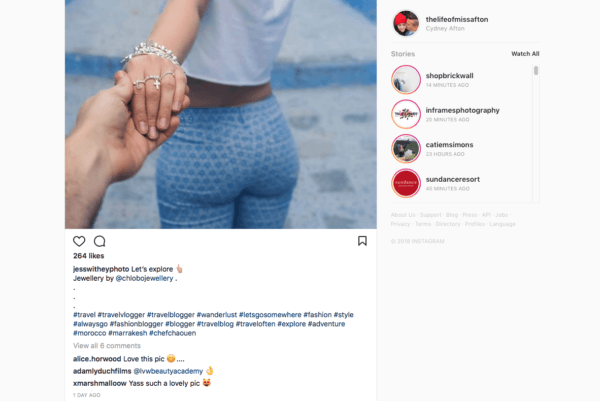
By doing this, you can create a pleasant visual experience for your target audience to read without a lot of hashtag clog up!
Put hashtags in your comments! Want to forgo the typing, period and asterisk? Forget it! Just put your hashtags in your comments below! (Make sure it’s the first comment). Once other people leave a few comments, the hashtags won’t be viewable!
Do Some Market Research
Brainstorm ideas and topics that apply to your business and enter those ideas as a hashtag into Instagram, Twitter, Facebook or other platforms you might be using.
Think about the following:
- What is your business about?
- What products of services do you provide?
- Is there a style your business serves to customers? (vintage, boho, etc)
- Where is your business serving clients?
- What does your brand signify?
- Are there social or political movements you want to be included in?
List these ideas and topics that apply to your business and enter those ideas into social platform searches and see what comes up! A lot of the time, platforms will provide related tags so see how you can improve and specify.
Another important piece of market research is watching your competition.
Look at competitors or your followers and see what hashtags they are using. Scroll through their list and pull a few that might work for you and test them out. See what others in your industry both located near you geographically and nationally and see what hashtags they are using.
Research can pay off big time if you’re looking at individuals that are in a similar industry and sharing work that is similar to your brand message and imagery.
Dare to Use Big and Small
A strategy you can use is to mix popular hashtags that appeal to a larger audience and more targeted less popular ones that will more likely ensure that my content is going to be placed in the “top” section of that hashtag.
Pay attention to the number of people who have used the hashtags and prioritize them by popularity or how targeted they are to cast your net wide among both popular hashtags and smaller, more targeted ones. By showing up in all the places and see which yields the greater results for your efforts.
Using a variety of hashtags is key to stay relevant and effective in your hashtag strategy.
Find Your Numbers
91% of brands use seven or fewer hashtags per post, so it’s easy to assume that’s the magic number for everyone…right?
Well, not exactly.
The point is, like most marketing techniques, it requires testing! For many businesses, it’s good to start at the best practices number and test out what works best from there. Although it might take several months to find the “sweet spot” of hashtag numbers, give yourself flexibility for trial and error for best results!
Create Voice and Personality
Beyond simply organizing your tweets, hashtags can serve as a way to create a business personality online. Hashtags are not just for organizing content, they can be used for humor and emotions that your brand struggles to portray. This is a popular trend lately for people who want to be included in political, social and personal movements.
For example, there are a lot of tweets lately that have created a strong emotional stance like:
- #NotMyPresident
- #MeToo
- #Fail
- #BlackLivesMatter
- #TakeAKnee
- #Covfefe
Each of those, if included in a post, can create a strong message as to where a business or personal brand stands. For example, Jesse Williams, Shonda Rhymes and the cast of Grey’s Anatomy strategically used the #TakeAKnee hashtag to make a political and social statement that they support NFL Athletes in the #TakeAKnee Movement.
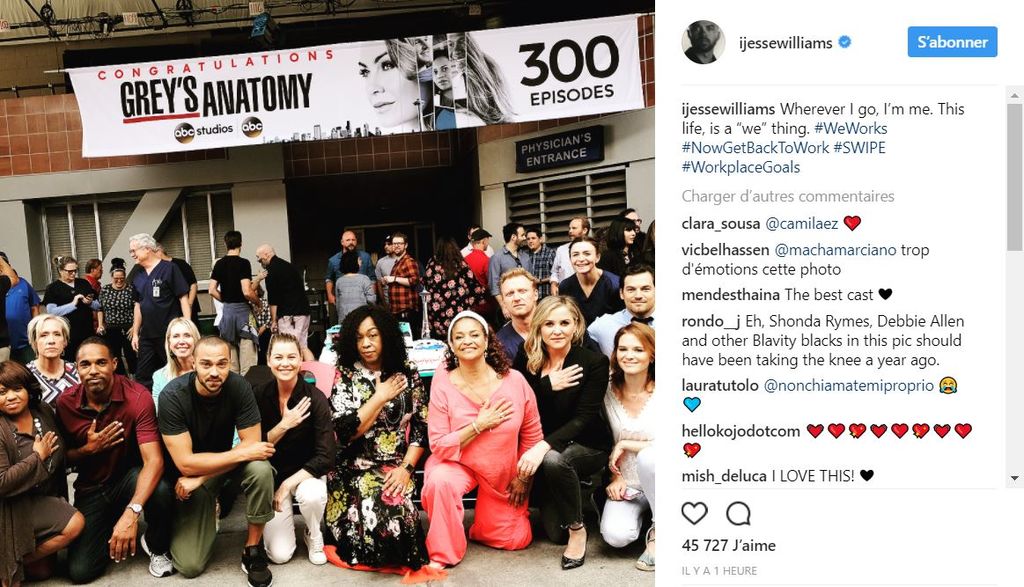
As politics always get messy, hashtags can also be used for humorous commentary during an online discussion. For example, a business can be really funny like Charmin Toilet Paper:
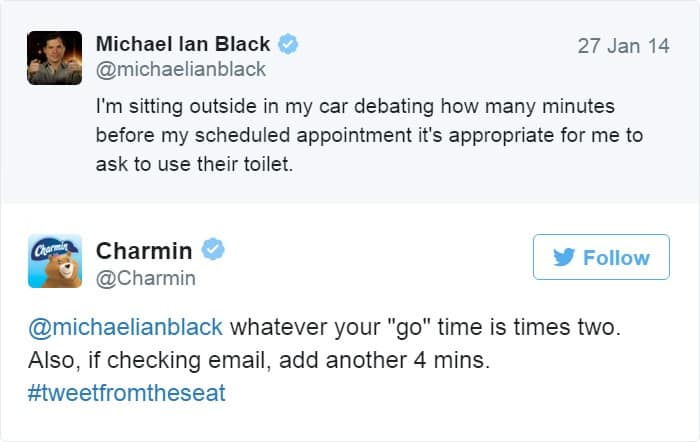
Charmin responded to a tweet relating to “going to the bathroom” and added a funny hashtag relating to their business. This not only is a humorous helpful hint but it adds a dash of humor that followers appreciate
If you are nervous that you are not the witty type, hashtags can also be used relatably by using common experience hashtags like:
- It’s the Freaking Weekend! #TGIF
- Wearing socks with Crocs is so stylish #kidding
- Just dropped my phone in the toilet. #fail
- I’m loving Michelle Obama’s new book this week! #FridayReads
Hashtags generally are a great way to add some personality into your business tone online whether its for social stances, humor or relatability.
Create a Hashtag Campaign
Often, the best branded campaigns on social media are those with an important and meaningful purpose. If you are starting a new product line or service, take a chance and make a branded hashtag campaign to create some traffic to your new additions!
For example in 2017, the Worldwide Breast Cancer organization launched its hashtag campaign #KnowYourLemons to convince women to check their breasts for signs of cancer more frequently.
The catchy concept went viral almost instantly as it was a fun and creative way to give women information that will help their health. The charity then launched its own Facebook member’s page where people could take part in conversations about women’s health.
By creating an intimate place to continue the conversation, they made the hashtag and movement stick!

The creativity in this hashtag campaign was a fantastic way to raise awareness for an important cause. This campaign also made the information available to everyone so they could learn about breast cancer.
Like them, you too can create a creative and meaningful campaign using hashtags that will gain much attention and branded education.
Generate Some Buzz
Creating a contest, raffle or promotion is a great way to get social media platforms talking about your brand.
Those who see your posts are more likely to get involved if they see an incentive to do so. For example, Dominos did an awesome job with their “Prove You’re a Superfan with a Photo Contest.”

You can for sure take a cue from Domino’s and run a giveaway with a worthwhile reward that motivates your audience to engage with your brand. I mean, they made people question their love for Dominos by asking:
Are you a fan, or are you a superfan?
For a chance to win an amazing $10k prize, Domino’s asked fans to share a photo that proves their “superfan-dom” using the hashtag #PieceOfThePieContest.
From the simple to the elaborate, there are various ways to set up a hashtag giveaway on social media. The benefit? They’re easy to manage and you can experiment with a few different types of contests and prizes to figure out what works for your target audience.
Again, followers will be more likely to retweet your hashtags if they know they might win a prize by doing so.
Hashtags, Now You Know!
After reading this article, you should see many ways that hashtags can be used for your social media marketing! Hashtags can be a great way to attract your ideal clients, connect you to other creatives and brand your business.
Use them thoughtfully, sparingly and do your research for the best results and you will see some business wins!
So tell me, what hashtags are you using currently in your business? What do you love most about hashtags? Comment below!

